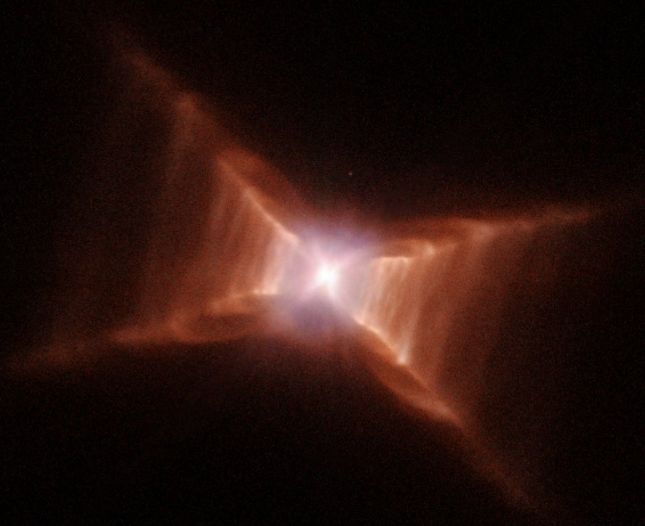Credit & Copyright: H. Van Winckel (KU Leuven),
M. Cohen (UC Berkeley),
H. Bond (STScI).
T. Gull (GSFC),
ESA,
NASA
Explanation:
A distinctive X-shape and ladder-like rungs appear in
this Hubble Space Telescope
image of the intriguing
Red Rectangle Nebula.
The dusty cosmic cloud was originally identified as
a strong source of
infrared
radiation and is now
believed to contain icy dust grains and hydrocarbon
molecules formed in the cool outflow from an aging
central star.
So why does it look like a big X?
A likely explanation is that the
central star - actually a close pair of stars - is surrounded by
a thick dust torus which pinches the otherwise spherical
outflow into tip-touching cone shapes.
Because we view the torus edge-on, the boundary edges of
the cone shapes seem to form an X.
The distinct rungs suggest the outflow occurs in
fits and starts.
About 2,300 light-years away toward the fanciful constellation
Monoceros,
the Red Rectangle nebula should be transformed
into a glorious planetary nebula
as its cool central star becomes a
hot white dwarf over
the next few thousand years.
This sharp Hubble picture spans only about one third of a light-year
at the distance of the Red Rectangle.
1999 2000 2001 2002 2003 2004 2005 2006 2007 2008 2009 2010 2011 2012 2013 2014 2015 2016 2017 2018 2019 2020 2021 2022 2023 2024 2025 |
Yanvar' Fevral' Mart Aprel' Mai Iyun' Iyul' Avgust Sentyabr' Oktyabr' Noyabr' Dekabr' |
NASA Web Site Statements, Warnings, and Disclaimers
NASA Official: Jay Norris. Specific rights apply.
A service of: LHEA at NASA / GSFC
& Michigan Tech. U.
|
Publikacii s klyuchevymi slovami:
planetary nebula - dust - Planetarnaya tumannost'
Publikacii so slovami: planetary nebula - dust - Planetarnaya tumannost' | |
Sm. takzhe:
Vse publikacii na tu zhe temu >> | |
